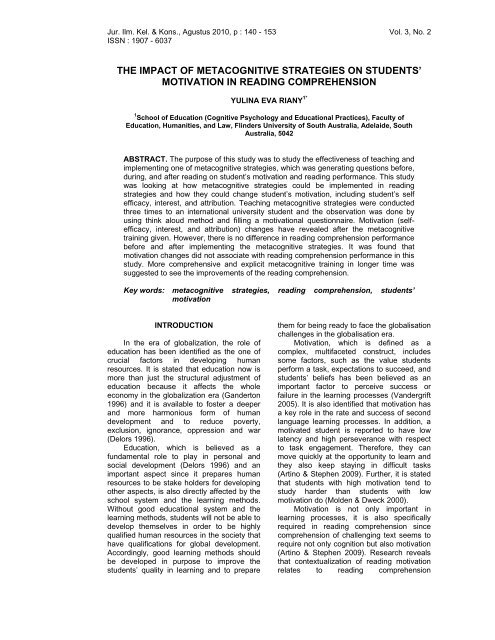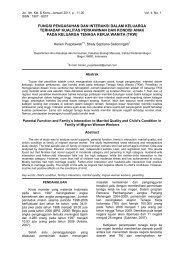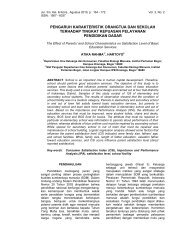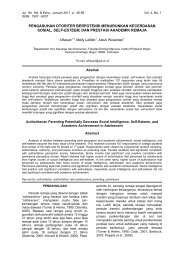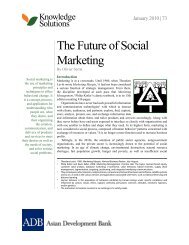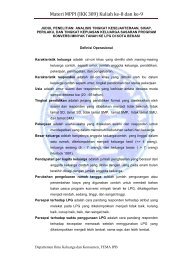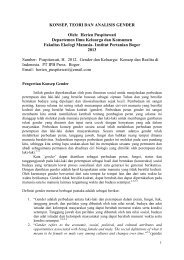motivation in reading comprehension
motivation in reading comprehension
motivation in reading comprehension
Create successful ePaper yourself
Turn your PDF publications into a flip-book with our unique Google optimized e-Paper software.
Vol. 3, 2010 METACOGNITIVE STRATEGIES 141performance (Anmarkrud & Braten 2009).This means that <strong>motivation</strong> is one of keyfactors for students to succeed <strong>in</strong>comprehend<strong>in</strong>g read<strong>in</strong>g.Research reveals that <strong>motivation</strong>,especially self efficacy and <strong>in</strong>tr<strong>in</strong>sic<strong>motivation</strong> is also positively associated withmetacognitive strategies. This means thatmetacognitive strategies are found to havepositive re<strong>in</strong>forcements on students’<strong>motivation</strong> aspects, particularly students’ selfefficacy (Wang et al. 2009). Schraw (1998)def<strong>in</strong>ed metacognition as awareness andmonitor<strong>in</strong>g of one’s thoughts and taskperformance. In other words, metacognitionis identified as th<strong>in</strong>k<strong>in</strong>g about your th<strong>in</strong>k<strong>in</strong>g(Schraw 1998). It is related to high capacityof mental processes, which is <strong>in</strong>volved <strong>in</strong>learn<strong>in</strong>g processes, such as mak<strong>in</strong>g plans forlearn<strong>in</strong>g, us<strong>in</strong>g appropriate skills andstrategies to solve a problem <strong>in</strong> learn<strong>in</strong>gprocesses, estimat<strong>in</strong>g performance <strong>in</strong>learn<strong>in</strong>g, and also calibrat<strong>in</strong>g the extent oflearn<strong>in</strong>g (Cout<strong>in</strong>ho 2007).Schraw (1998) has stated thatmetacognition is consisted of two majorcomponents: metacognitive knowledge andmetacognitive regulation. Metacognitiveknowledge refers to knowledge of cognition,which means that what <strong>in</strong>dividuals knowabout their own cognition or about cognition<strong>in</strong> general, such as knowledge of skills andstrategies that work best for the learners, andknowledge about how and when to use suchskills and strategies. In one hand,metacognitive regulation is def<strong>in</strong>ed as a setof activities that control learners’ thoughtsand learn<strong>in</strong>g activities, <strong>in</strong>clud<strong>in</strong>g plann<strong>in</strong>g,monitor<strong>in</strong>g <strong>comprehension</strong>, and evaluation(Schraw 1998).Accord<strong>in</strong>g to Wang et al. (2009), strongmetacognitive strategies and beliefs canempower second language learners. Anotherresearch also reveals that students with agreater use of metacognitive strategies arereported to be more <strong>motivation</strong>al <strong>in</strong>tensitywith some evidence of a self determ<strong>in</strong>ationcont<strong>in</strong>uum evident <strong>in</strong> the respond patterns(Vandergrift 2005).In addition, metacognitive strategies arenot only believed as factors that canstrengthen one’s <strong>motivation</strong> <strong>in</strong> learn<strong>in</strong>g, butalso one’s performance <strong>in</strong> comprehend<strong>in</strong>gread<strong>in</strong>g. This is because read<strong>in</strong>g as a multicomponential and multi layered activityrequires not only cognition, but also numberof <strong>motivation</strong> and metacognitive strategies to<strong>in</strong>vestigate and to perform the read<strong>in</strong>g textscomprehensively (Sporer et al. 2007).Moreover, it is also stated that when studentsare more metacognitively aware dur<strong>in</strong>gread<strong>in</strong>g, their <strong>comprehension</strong> <strong>in</strong> read<strong>in</strong>g willenhance (Israel et al. 2005). Accord<strong>in</strong>gly, thisstudy was observ<strong>in</strong>g and explor<strong>in</strong>g theeffectiveness of implement<strong>in</strong>g metacognitivestrategies on students’ <strong>motivation</strong> andread<strong>in</strong>g <strong>comprehension</strong> performance. Thisstudy was also observ<strong>in</strong>g the associationbetween <strong>motivation</strong> changes and read<strong>in</strong>g<strong>comprehension</strong> performance.In order to identify the effectivenessteach<strong>in</strong>g, model<strong>in</strong>g and implement<strong>in</strong>gmetacognitive strategies on student’s<strong>motivation</strong> and read<strong>in</strong>g <strong>comprehension</strong>performance, there are research questionsaddressed. This practical project willaddress the follow<strong>in</strong>g research questions:1. How students can implementmetacognitive strategies with<strong>in</strong> theirread<strong>in</strong>g strategies?2. What is the impact of implement<strong>in</strong>gmetacognitive strategies with<strong>in</strong> students’read<strong>in</strong>g <strong>comprehension</strong> strategies ontheir read<strong>in</strong>g <strong>comprehension</strong>performance?3. What is the impact of implement<strong>in</strong>gmetacognitive strategies with<strong>in</strong> students’read<strong>in</strong>g <strong>comprehension</strong> strategies ontheir <strong>motivation</strong>?4. What is association between <strong>motivation</strong>change and students’ read<strong>in</strong>g<strong>comprehension</strong> peformance?Generally, this study aims to determ<strong>in</strong>ethe effectiveness teach<strong>in</strong>g and implement<strong>in</strong>gone strategy of metacognitive strategies,which was generat<strong>in</strong>g questions, on student’s<strong>motivation</strong> and performance <strong>in</strong> read<strong>in</strong>g<strong>comprehension</strong>. This research was look<strong>in</strong>g athow the metacognitive strategies wereimplemented <strong>in</strong> read<strong>in</strong>g strategies and alsohow they could change student’s <strong>motivation</strong><strong>in</strong> read<strong>in</strong>g, <strong>in</strong>clud<strong>in</strong>g student’s self efficacy,<strong>in</strong>terest, and also attribution.METHODSParticipant DetailsIn this study, a case study was appliedby observ<strong>in</strong>g and conduct<strong>in</strong>g the <strong>in</strong>terventionon one participant. A convenience sampl<strong>in</strong>gwas applied by select<strong>in</strong>g participantsbecause they are will<strong>in</strong>g and available toparticipate <strong>in</strong> the study (Creswell 2008). Onepostgraduate female student with age 30
142 RIANY Jur. Ilm. Kel. & Kons.years old attend<strong>in</strong>g university <strong>in</strong> Adelaide,South Australia was recruited <strong>in</strong> this study.DesignA mix method observational studydesign was conducted <strong>in</strong> this study. Theobservational study design has been chosenas a method <strong>in</strong> this study because thisresearch engaged <strong>in</strong> <strong>in</strong>tensive datacollection, spend<strong>in</strong>g a great deal of time atthe site where participants engaged <strong>in</strong>read<strong>in</strong>g processes, so detailed <strong>in</strong>formationwas able to be gathered by observation ofeach participant (Silverman 2005). Thisobservational study engaged <strong>in</strong> the <strong>in</strong>tensivedata collection of participants’ read<strong>in</strong>g<strong>comprehension</strong> strategy (<strong>in</strong>clud<strong>in</strong>gconcurrent and retrospective th<strong>in</strong>k-aloud anddata from questionnaire).In addition, mixed method study designhas been def<strong>in</strong>ed as procedure for collect<strong>in</strong>g,analys<strong>in</strong>g, and mix<strong>in</strong>g both qualitative andquantitative data <strong>in</strong> a s<strong>in</strong>gle study or <strong>in</strong> amultiphase series of studies (Creswell &Clark 2005). Accord<strong>in</strong>gly, this study gatheredboth qualitative data (th<strong>in</strong>k-aloud data) andquantitative data (scale scores from the<strong>motivation</strong>al questionnaire).InstrumentationThere were two <strong>in</strong>strumentations used<strong>in</strong> this study, a <strong>motivation</strong>al questionnaireand IELTS read<strong>in</strong>g <strong>comprehension</strong> texts (pretest and post test) (Appendix 1). A<strong>motivation</strong>al questionnaire was given <strong>in</strong> pretest and post test to identify participant’s<strong>motivation</strong> changes.In addition, IELTS read<strong>in</strong>g<strong>comprehension</strong> texts were used <strong>in</strong> this studyas materials for read<strong>in</strong>g and the questionsprovided were used to assess participant’sread<strong>in</strong>g <strong>comprehension</strong> performance. Thereason why these topics were chosen fromthe IELTS test was because IELTS test hadbeen used as an International Englishacademic <strong>comprehension</strong> test. Therefore, thetopic would be familiar to all secondlanguage (L2) students, so it was expected tobe easily performed by participant, who hasEnglish as their second (L2) or foreignlanguage. It was found that topic familiaritywould enhance students’ degree of<strong>in</strong>volvement <strong>in</strong> the task (Roca de Larios et al.2008). It was expected that the tasks wouldalso be of similar difficulty.Furthermore, this study was us<strong>in</strong>g twodata collect<strong>in</strong>g methods. First, participantwas asked to do th<strong>in</strong>k aloud, which wasrecord<strong>in</strong>g her voice while she was read<strong>in</strong>gand comprehend<strong>in</strong>g the read<strong>in</strong>g texts. Th<strong>in</strong>kaloud <strong>in</strong>struction was ask<strong>in</strong>g participant tosay everyth<strong>in</strong>g that come to her m<strong>in</strong>d whileread<strong>in</strong>g a text. This method is important toobserve participant’s work<strong>in</strong>g memory whiledo<strong>in</strong>g read<strong>in</strong>g <strong>comprehension</strong>. After she didth<strong>in</strong>k-aloud, she was also asked forretrospective <strong>in</strong>terview. In this <strong>in</strong>terview,participant was asked some questionsrelated to her strategy <strong>in</strong> read<strong>in</strong>g (before andafter the metacognitive tra<strong>in</strong><strong>in</strong>g). Participant’srespond was also recorded to know the<strong>in</strong>formation about her strategy <strong>in</strong> read<strong>in</strong>g.The other method was giv<strong>in</strong>g participanta <strong>motivation</strong>al questionnaire to fill. Thisquestionnaire was used <strong>in</strong> order to identifyher <strong>motivation</strong> <strong>in</strong> read<strong>in</strong>g. The questionnairewas given <strong>in</strong> pre and post tests.Th<strong>in</strong>k-aloud method. Th<strong>in</strong>k-aloud hasbeen def<strong>in</strong>ed as a method, which <strong>in</strong>volvesrecord<strong>in</strong>g everyth<strong>in</strong>g that participants say(Creswell 2008). This study has applied aconcurrent report of cognitive processes bygenerat<strong>in</strong>g the participants’ plann<strong>in</strong>g activitythrough use of a th<strong>in</strong>k-aloud procedure.Accord<strong>in</strong>g to Lawson and Hogben (1996),even though the th<strong>in</strong>k-aloud procedure hadseveral limitations like other data gather<strong>in</strong>gprocedures, the products of cognitive activitythat were <strong>in</strong> the current focus of attention canbe expected to be well reported (Ericsson &Simon 1993).In a concurrent th<strong>in</strong>k-aloud procedureparticipants are not asked to describe orexpla<strong>in</strong> what was be<strong>in</strong>g done. Rather theyreported on the thoughts that were <strong>in</strong> thefocus of their attention (Lawson & Hogben1996). Th<strong>in</strong>k-aloud procedures have nowbeen applied <strong>in</strong> several language learn<strong>in</strong>gstudies, such as for vocabulary acquisitions,self-regulated learn<strong>in</strong>g strategy, and so fortheven though none of these studies hadengaged students <strong>in</strong> the type of task appliedhere (Lawson & Hogben 1996).In this study, the concurrent th<strong>in</strong>k aloudmethod was applied to gather th<strong>in</strong>k-alouddata s<strong>in</strong>ce it was believed that it wouldpresent a more accurate picture ofparticipants’ on-l<strong>in</strong>e process<strong>in</strong>g <strong>in</strong> theirwork<strong>in</strong>g memories while comprehend<strong>in</strong>gread<strong>in</strong>g texts. Moreover, this concurrentstrategy of th<strong>in</strong>k aloud process was importants<strong>in</strong>ce this study also entailed count<strong>in</strong>g theactual time spent on different read<strong>in</strong>gstrategies <strong>in</strong> read<strong>in</strong>g activities.Th<strong>in</strong>k-aloud <strong>in</strong>struction <strong>in</strong> the presentstudy was expla<strong>in</strong>ed by ask<strong>in</strong>g all of
Vol. 3, 2010 METACOGNITIVE STRATEGIES 141participant to say everyth<strong>in</strong>g that come totheir m<strong>in</strong>d while comprehend<strong>in</strong>g the read<strong>in</strong>gtasks. In this method, participant was allowedto use either English or her first language asthe language of report<strong>in</strong>g. The reason for thiswas to make her feel more comfortable <strong>in</strong>perform<strong>in</strong>g the read<strong>in</strong>g task. Participant wasgiven the opportunity to practice the th<strong>in</strong>kaloudmethod by expla<strong>in</strong><strong>in</strong>g aloud how to getfrom the current site to a build<strong>in</strong>g she wasfamiliar with. Feedback on this practice wasprovided to emphasize the importance ofgiv<strong>in</strong>g a full report of what she was th<strong>in</strong>k<strong>in</strong>g.No model<strong>in</strong>g was provided to avoid<strong>in</strong>fluenc<strong>in</strong>g the participants’ behaviour.Data Analysis TechniquesData that were collected byquestionnaire and read<strong>in</strong>g questions wereanalysed by Microsoft Excel. Moreover,qualitative data from participants th<strong>in</strong>k-aloudwere analysed by cod<strong>in</strong>g, categorization, andalso <strong>in</strong>terpretation. The cod<strong>in</strong>g process foranalysis of th<strong>in</strong>k-aloud data was also carriedout us<strong>in</strong>g Microsoft Excel software. The datawere coded us<strong>in</strong>g a set of codes based oncognitive theories of metacognition <strong>in</strong> do<strong>in</strong>gread<strong>in</strong>g <strong>comprehension</strong>. The qualitative datafrom participants th<strong>in</strong>k-aloud were identifiedwhether it <strong>in</strong>dicated the metacognitivestrategies <strong>in</strong> read<strong>in</strong>g <strong>comprehension</strong> or not.Also, from th<strong>in</strong>k-aloud data, it was identifiedwhether there was improvements <strong>in</strong> do<strong>in</strong>gmetacognitive strategies while read<strong>in</strong>g or not.After that, the association between themetacognitive strategies while read<strong>in</strong>g andthe <strong>motivation</strong> of read<strong>in</strong>g <strong>comprehension</strong> wasalso identified.ProcedurePretest. Observ<strong>in</strong>g participant’s read<strong>in</strong>gstrategies was done by implement<strong>in</strong>g th<strong>in</strong>kaloud method. This method was done <strong>in</strong>order to identify whether participant hasalready applied metacognitive strategies <strong>in</strong>her read<strong>in</strong>g strategies or not. Th<strong>in</strong>k aloudmethod was used also to explore sort ofstrategies that participant has already applied<strong>in</strong> comprehend<strong>in</strong>g read<strong>in</strong>g text. Moreover,this method was used to supportidentification <strong>in</strong> participant’s <strong>motivation</strong>(particularly attribution).In this th<strong>in</strong>k aloud method, participantwas asked to do two methods <strong>in</strong> th<strong>in</strong>k aloudprocedure, there were concurrent strategyand retrospective procedures.1. In concurrent procedure, participant wasasked to read aloud read<strong>in</strong>g passagewithout stopp<strong>in</strong>g. This strategy wasidentify<strong>in</strong>g what strategies thatparticipant had used <strong>in</strong> read<strong>in</strong>g<strong>comprehension</strong>.2. In retrospective procedure, participantwas asked to review her read<strong>in</strong>gstrategies by answer<strong>in</strong>g some questions,such as :a. What sort of strategy that you haveused to understand the read<strong>in</strong>gpassage?b. How can you grasp the ma<strong>in</strong> idea <strong>in</strong>read<strong>in</strong>g passage?c. What do you do well as a reader <strong>in</strong>comprehend<strong>in</strong>g read<strong>in</strong>g passage?d. Do you have sort of specific strategy<strong>in</strong> comprehend<strong>in</strong>g read<strong>in</strong>g?e. What do you do before start read<strong>in</strong>g?f. What do you do while you areread<strong>in</strong>g to get more idea ofunderstand<strong>in</strong>g read<strong>in</strong>g?g. What do you do when you come to aword you don’t understand?h. When you come to a part of the textthat is confus<strong>in</strong>g, what do you do?i. After you f<strong>in</strong>ish read<strong>in</strong>g, what do youdo?After f<strong>in</strong>ish read<strong>in</strong>g, participant wasasked to answer some questions related tothe read<strong>in</strong>g passage <strong>in</strong> order to measure herread<strong>in</strong>g <strong>comprehension</strong> performance. Thequestions were already provided <strong>in</strong> IELTStexts.Then, <strong>in</strong>dentify<strong>in</strong>g participant’s<strong>motivation</strong>, <strong>in</strong>clud<strong>in</strong>g measur<strong>in</strong>g participant’sself efficacy, <strong>in</strong>terests, and attribution <strong>in</strong>do<strong>in</strong>g read<strong>in</strong>g <strong>comprehension</strong> was done byask<strong>in</strong>g participant to fill a <strong>motivation</strong>alquestionnaire. In this questionnaire,participant was asked to generate herconfidence <strong>in</strong> perform<strong>in</strong>g read<strong>in</strong>g texts withscale 1 to 7 (strongly disagree – stronglyagree).The results of pretest were used toidentify whether participant had alreadyapplied metacognitive strategies <strong>in</strong> read<strong>in</strong>g ornot. Also, this pretest was identify<strong>in</strong>gparticipant’s skills <strong>in</strong> comprehend<strong>in</strong>g read<strong>in</strong>gand her <strong>motivation</strong>.Intervention. The <strong>in</strong>tervention wasdone by focus<strong>in</strong>g on implementation ofmetacognitive strategies <strong>in</strong> student’s read<strong>in</strong>gstrategies. The <strong>in</strong>tervention strategy wasteach<strong>in</strong>g participant <strong>in</strong> generat<strong>in</strong>g somequestions before, while, and after read<strong>in</strong>g.This strategy aims to guide participant do<strong>in</strong>gmetacognitive plann<strong>in</strong>g, monitor<strong>in</strong>g, andevaluat<strong>in</strong>g strategies.
142 RIANY Jur. Ilm. Kel. & Kons.1. Plann<strong>in</strong>g strategyIn this part of <strong>in</strong>tervention, participant wasguided to: set the goals of read<strong>in</strong>g passage predict what the read<strong>in</strong>g will tellabout create a connection between read<strong>in</strong>gtexts and prior knowledge2. Monitor<strong>in</strong>g strategyIn this part of <strong>in</strong>tervention, participant wasguided to:monitor <strong>comprehension</strong> by alwayscontroll<strong>in</strong>g his/her understand<strong>in</strong>gwhen she was read<strong>in</strong>g text bygenerat<strong>in</strong>g some questions related toread<strong>in</strong>g passage. pause her self whether she could notgrasp the idea of the texts. comprehend the text by <strong>in</strong>tegrat<strong>in</strong>gmean<strong>in</strong>g relations words by words orsentences by sentences.3. Evaluat<strong>in</strong>g strategyIn this <strong>in</strong>tervention, participant was guidedto: generate several questions <strong>in</strong> orderto ask his/ her understand<strong>in</strong>g ofread<strong>in</strong>g passage. review the understand<strong>in</strong>g of read<strong>in</strong>gtexts.The <strong>in</strong>tervention guidel<strong>in</strong>e is presented asbelow,In implement<strong>in</strong>g <strong>in</strong>tervention procedure,participant was taught how to implementmetacognitive strategies <strong>in</strong> read<strong>in</strong>g<strong>comprehension</strong> by giv<strong>in</strong>g explanation howimportant apply<strong>in</strong>g metacognitive strategies<strong>in</strong> read<strong>in</strong>g <strong>comprehension</strong> strategy.Moreover, model<strong>in</strong>g was presented to guideparticipant more understand <strong>in</strong> apply<strong>in</strong>gstrategy <strong>in</strong> read<strong>in</strong>g <strong>comprehension</strong>.There were three steps <strong>in</strong> teach<strong>in</strong>gmetacognitive strategies:1. Participant was guided to implementplann<strong>in</strong>g metacognitive strategies bysett<strong>in</strong>g some goals, predict<strong>in</strong>g theread<strong>in</strong>g about, and activat<strong>in</strong>g priorknowledge related to the texts before shestarted read<strong>in</strong>g passage by generat<strong>in</strong>gsome questions to herself, such as :a. Do I read the title and head<strong>in</strong>gs?b. Do I look at the pictures?c. Do I predict what the passage mightbe about?d. Do I ask myself what I already knowabout the topic?e. Do I need to read this read<strong>in</strong>gpassage?f. Do I need to use organizationalstructure of text to help meunderstand this read<strong>in</strong>g passage?2. After that, participant was guided toimplement monitor<strong>in</strong>g metacognitivestrategies by generat<strong>in</strong>g some questionsto monitor her understand<strong>in</strong>g whileread<strong>in</strong>g by ask<strong>in</strong>g herself somequestions, such as :a. Do I th<strong>in</strong>k about what I am read<strong>in</strong>g?b. Do I pause or stop sometimes andask myself whether I understand theread<strong>in</strong>g or not what I have readabout so far?c. Do I picture <strong>in</strong> my m<strong>in</strong>d the people,places, and events I am read<strong>in</strong>gabout?d. Do I imag<strong>in</strong>e that I am talk<strong>in</strong>g withthe author while I am read<strong>in</strong>g?e. Do I consider some options when Iam try<strong>in</strong>g to answer the questionsthat I have asked before read<strong>in</strong>g?f. Do I need to review what I have read<strong>in</strong> order to understand the read<strong>in</strong>g?g. Do I analyse the content of read<strong>in</strong>galready?h. Do I translate the <strong>in</strong>formation that Ihave read <strong>in</strong> my own words?i. Do I still keep myself on the track theread<strong>in</strong>g?j. Do I look for clues and try to figure itout?k. Do I use a glossary or dictionary if Ido not know the words, sentence, orpassage?3. Lastly, participant was taught to generatesome questions <strong>in</strong> order to do evaluat<strong>in</strong>gand review<strong>in</strong>g read<strong>in</strong>g <strong>comprehension</strong>,such as :a. Do I read the text aga<strong>in</strong>?b. Do I just keep read<strong>in</strong>g?c. Do I try to get help from pictures ordraw<strong>in</strong>gs?d. Do I th<strong>in</strong>k about what I have read?e. Do I do someth<strong>in</strong>g with the<strong>in</strong>formation that I have learned?f. Do I compare what I have just readwith what I already knew?Participant was taught the strategies <strong>in</strong>implement<strong>in</strong>g metacognitive strategies atleast 3 times before f<strong>in</strong>ally she was asked todo post test. This strategy was done <strong>in</strong> orderto make participant more familiar <strong>in</strong>implement<strong>in</strong>g the metacognitive strategy <strong>in</strong>his read<strong>in</strong>g <strong>comprehension</strong>.Post test/Measurement. In post test,participant was asked to do the same
Vol. 3, 2010 METACOGNITIVE STRATEGIES 141activities as <strong>in</strong> pre test. She was asked to doth<strong>in</strong>k aloud while she was read<strong>in</strong>g a differenttext with the same level of difficulty takenfrom IELTS read<strong>in</strong>g test. Then, she wasasked to answer some questions related tothe read<strong>in</strong>g passage <strong>in</strong> order to measure hercomprehend<strong>in</strong>g <strong>in</strong> read<strong>in</strong>g. Lastly, she wasasked to fill the same <strong>motivation</strong>alquestionnaire to identify <strong>motivation</strong> changesafter the <strong>in</strong>terventions.The post test of this study aims toassess:1. The implementation of metacognitivestrategies <strong>in</strong> participant’s read<strong>in</strong>gstrategies. The result of this part wasused to identify how participant couldapply metacognitive strategies <strong>in</strong> herread<strong>in</strong>g <strong>comprehension</strong>.2. Participant’s read<strong>in</strong>g <strong>comprehension</strong>improvement. The result of this part wasused to know the impact of implement<strong>in</strong>gmetacognitive strategies on participant’sread<strong>in</strong>g <strong>comprehension</strong> performance.3. Participant’s <strong>motivation</strong> changes <strong>in</strong>read<strong>in</strong>g <strong>comprehension</strong>. The result ofthis part was used to compareparticipant’s <strong>motivation</strong>, <strong>in</strong>clud<strong>in</strong>g selfefficacy, <strong>in</strong>terests, and attribution beforeand after <strong>in</strong>tervention, whether therewere changes <strong>in</strong> participant’s <strong>motivation</strong>or not after implement<strong>in</strong>g metacognitivestrategies <strong>in</strong> read<strong>in</strong>g strategies.In order to check whether participantunderstood about metacognitive strategies,which were taught, or not, she was asked toexpla<strong>in</strong> her understand<strong>in</strong>g about thestrategies and was also asked to teachanother person the same read<strong>in</strong>g strategiesas she was received. This strategy wasapplied <strong>in</strong> order to evaluate the effectivenessof the <strong>in</strong>tervention method, which was taughtto participant.RESULTS AND DISCUSSIONRead<strong>in</strong>g Comprehension Strategies1. How student can apply metacognitivestrategies with<strong>in</strong> their read<strong>in</strong>g strategies?It was found that participant did notknow the concept about metacognition <strong>in</strong>read<strong>in</strong>g before the <strong>in</strong>tervention. Thiscondition was revealed from her th<strong>in</strong>k aloudread<strong>in</strong>g and the <strong>in</strong>terview results, which didnot <strong>in</strong>dicate her knowledge aboutmetacognition and her implementation ofmetacognitive strategies <strong>in</strong> read<strong>in</strong>g.Moreover, data revealed that she neverapplied metacognitive strategies <strong>in</strong>comprehend<strong>in</strong>g her read<strong>in</strong>g before, dur<strong>in</strong>g,and after read<strong>in</strong>g before the <strong>in</strong>terventionprocesses. She said that she did not havespecific strategy <strong>in</strong> read<strong>in</strong>g and she just didskim and scan strategies <strong>in</strong> read<strong>in</strong>g. Thereason for this was because she thought thatshe could already grasp the whole idea of thetexts only by look<strong>in</strong>g at the ma<strong>in</strong> idea andkeywords. Moreover, she said that apply<strong>in</strong>gspecific strategy might take long time. (I haveno specific strategy <strong>in</strong> read<strong>in</strong>g because Idon’t need to understand the whole read<strong>in</strong>gpassages….. I just need to look at the ma<strong>in</strong>po<strong>in</strong>ts and keywords on the texts to get thewhole idea because I have no enough time).Therefore, she only did read<strong>in</strong>g through thepassage without check<strong>in</strong>g her deepunderstand<strong>in</strong>g about the whole idea of thetexts or <strong>in</strong> other words, she never tried tocomprehend the read<strong>in</strong>gs properly.Accord<strong>in</strong>g to Paris and W<strong>in</strong>ograd (1990)cited <strong>in</strong> Pierce (2003), less skilled readerstended to be limited <strong>in</strong> their ability to applymetacognitive strategies. Therefore, it couldbe identified that participant might be lessskilled readers s<strong>in</strong>ce she never implementedsort of metacognitive strategies <strong>in</strong> check<strong>in</strong>gher comprehend<strong>in</strong>g <strong>in</strong> read<strong>in</strong>g before the<strong>in</strong>tervention.Nevertheless, accord<strong>in</strong>g to data fromth<strong>in</strong>k aloud, participant has shown changes<strong>in</strong> apply<strong>in</strong>g metacognitive strategies <strong>in</strong>read<strong>in</strong>g, which is generat<strong>in</strong>g questionsbefore, dur<strong>in</strong>g, and after read<strong>in</strong>g, after threetimes has been taught the metacognitivestrategies <strong>in</strong> read<strong>in</strong>g. Data showed that therewere some changes <strong>in</strong> participant’s plann<strong>in</strong>g,monitor<strong>in</strong>g, and evaluat<strong>in</strong>g strategies <strong>in</strong>comprehend<strong>in</strong>g read<strong>in</strong>g, particularly <strong>in</strong>check<strong>in</strong>g understand<strong>in</strong>g. Participantpresented generat<strong>in</strong>g some questions before,while, and after read<strong>in</strong>g to her self related tothe texts. This means that after the tra<strong>in</strong><strong>in</strong>gprocesses, participant showed changes <strong>in</strong>terms of apply<strong>in</strong>g one of metacognitivestrategies <strong>in</strong> read<strong>in</strong>g. Data results of eachstep <strong>in</strong> metacognitive strategies are go<strong>in</strong>g toanalyse and discuss <strong>in</strong> the follow<strong>in</strong>gsubhead<strong>in</strong>gs.Plann<strong>in</strong>g Strategy. Data before the<strong>in</strong>tervention revealed that participant did notdo plann<strong>in</strong>g before started read<strong>in</strong>g. Thismeans that she just did read<strong>in</strong>g through thepassage and she never did sett<strong>in</strong>g goals,generat<strong>in</strong>g questions, or other plann<strong>in</strong>gstrategies to acknowledge the read<strong>in</strong>g text
142 RIANY Jur. Ilm. Kel. & Kons.with her prior knowledge (I just do read<strong>in</strong>gstraight away… I don’t have anyth<strong>in</strong>g elsebefore read<strong>in</strong>g). In fact, comprehend<strong>in</strong>gread<strong>in</strong>g text requires both bottom-up wordsrecognition processes and top-down<strong>comprehension</strong> processes (Verhoeven &Perfetti 2008) and it also requires <strong>in</strong>tegrationmemory-based and constructivist aspects(Verhoeven & Perfetti 2008). This means that<strong>in</strong>tegrat<strong>in</strong>g read<strong>in</strong>g text with prior knowledgetends to be one of important factor to helpreaders comprehend<strong>in</strong>g read<strong>in</strong>g (Jetton2000). Analys<strong>in</strong>g data results are be<strong>in</strong>gpresented <strong>in</strong> Table 1.Data above present that participant haschanged <strong>in</strong> implement<strong>in</strong>g plann<strong>in</strong>g strategy ofread<strong>in</strong>g. Participant never did generat<strong>in</strong>gquestions and sett<strong>in</strong>g goals (metacognitivestrategies) before the <strong>in</strong>tervention. Rather,she was do<strong>in</strong>g translat<strong>in</strong>g words per wordsand sentences per sentences to grasp thema<strong>in</strong> idea and to comprehend the read<strong>in</strong>gtexts. However, after the <strong>in</strong>tervention,participant revealed changes <strong>in</strong> read<strong>in</strong>gstrategies. This was presented by herstrategy <strong>in</strong> <strong>in</strong>terpret<strong>in</strong>g the picture on the textbefore read<strong>in</strong>g texts, ask<strong>in</strong>g herself whethershe has prior knowledge about read<strong>in</strong>gpassage after read<strong>in</strong>g the title, look<strong>in</strong>gcarefully at title, pictures, and questionsprovided before started read<strong>in</strong>g, ask<strong>in</strong>gherself about the content of read<strong>in</strong>g will be,elaborat<strong>in</strong>g between her prior knowledge andread<strong>in</strong>g text. This means that theimplement<strong>in</strong>g metacognitive strategies havebeen applied <strong>in</strong> her read<strong>in</strong>g strategies,particularly <strong>in</strong> plann<strong>in</strong>g strategy.Monitor<strong>in</strong>g Strategy. Accord<strong>in</strong>g to th<strong>in</strong>kaloud data, participant revealed changes <strong>in</strong>terms of implement<strong>in</strong>g metacognitivestrategies <strong>in</strong> read<strong>in</strong>g, particularly <strong>in</strong>monitor<strong>in</strong>g strategy. Before the <strong>in</strong>tervention,she only did “pause her self” and “reread”when she found difficulty <strong>in</strong> grasp<strong>in</strong>g the ideaof texts. Also, she did paraphras<strong>in</strong>g the texts<strong>in</strong>to her words to check her understand<strong>in</strong>gwhile she was read<strong>in</strong>g the texts.Table 1. Data plann<strong>in</strong>g strategies <strong>in</strong> read<strong>in</strong>gCriteria Pre test Post testa. Plann<strong>in</strong>g Never does plann<strong>in</strong>g by sett<strong>in</strong>g the goals or sett<strong>in</strong>g times Never generates questions beforestart read<strong>in</strong>gShe was try<strong>in</strong>g to <strong>in</strong>terpret the picture onthe text (this picture conta<strong>in</strong>s men andwomen.. so, I bet this text will be aboutcomparison between men and womenachievement) She only reads directly the text anddoes not really keep attentionabout the mean<strong>in</strong>g of title or thegoal of read<strong>in</strong>g Just keep read<strong>in</strong>g the text withoutkeep<strong>in</strong>g attention to her priorknowledge related to the read<strong>in</strong>gtext Ask<strong>in</strong>g herself whether she has priorknowledge about read<strong>in</strong>g passage afterread<strong>in</strong>g the title (so do I know what themean<strong>in</strong>g of higher success rate amongwomen?)Look<strong>in</strong>g carefully at title and pictureLook<strong>in</strong>g at the questions provided beforestarted read<strong>in</strong>gAsk<strong>in</strong>g herself about the content ofread<strong>in</strong>g will be (is it about men’s andwomen’s achievement at works?)Elaborat<strong>in</strong>g between her prior knowledgeand read<strong>in</strong>g text (well, I th<strong>in</strong>k men will bebetter <strong>in</strong> perform<strong>in</strong>g management systemrather than women though…)
Vol. 3, 2010 METACOGNITIVE STRATEGIES 147Table 2. Data monitor<strong>in</strong>g strategies <strong>in</strong> read<strong>in</strong>gCriteria Pre test Post testb. Monitor<strong>in</strong>g She comprehended read<strong>in</strong>g bytranslat<strong>in</strong>g words to words andper sentence Paus<strong>in</strong>g herself when she found someth<strong>in</strong>g not clearenough.of sentences.Reread when she does notreally grasp the ideaParaphras<strong>in</strong>g the sentence <strong>in</strong>toher own words (so,researchers are try<strong>in</strong>g to f<strong>in</strong>dthe clue by identify<strong>in</strong>g bra<strong>in</strong>stuctures..) She comprehended read<strong>in</strong>g bytranslat<strong>in</strong>g words to words and persentence to grasp the idea of text.She was paus<strong>in</strong>g herself while she wasconfused about the sentences/ mean<strong>in</strong>gReread when she does not really graspthe ideaParaphras<strong>in</strong>g the sentence <strong>in</strong>to her ownwords (so, researchers are try<strong>in</strong>g to f<strong>in</strong>dthe clue by identify<strong>in</strong>g bra<strong>in</strong> stuctures..) Elaborat<strong>in</strong>g her understand<strong>in</strong>g about theread<strong>in</strong>g text by mak<strong>in</strong>g connection to herprior knowledge and tell<strong>in</strong>g herself tomake more understand the idea(Ehmmm… I see, that’s why nowadays anumber of women, who stay <strong>in</strong>management system has <strong>in</strong>creasedsteadily….)She was generat<strong>in</strong>g some questionsrelated to the sentences to understandmore (so why women can get the sameposition with men at works???.. do I reallyknow the reason?? ow.. I see….) She was ask<strong>in</strong>g herself about the idea ofthe read<strong>in</strong>g passage (ehmm… so what’sthe mean<strong>in</strong>g? Can I grasp the mean<strong>in</strong>ghere? Ow… maybe… women havealready shown off that they can be peoplewho are needed <strong>in</strong> management)Nevertheless, she showed changesafter the metacognitive tra<strong>in</strong><strong>in</strong>g <strong>in</strong>implement<strong>in</strong>g metacognitive strategies,particularly <strong>in</strong> monitor<strong>in</strong>g processes whileread<strong>in</strong>g. Besides do<strong>in</strong>g “paus<strong>in</strong>g her self”,reread<strong>in</strong>g, and paraphras<strong>in</strong>g the idea of thetexts, she also applied some metacognitivestrategies <strong>in</strong> read<strong>in</strong>g, such as elaborat<strong>in</strong>g herunderstand<strong>in</strong>g about the read<strong>in</strong>g text bymak<strong>in</strong>g connection to her prior knowledgeand tell<strong>in</strong>g herself to make more understandthe idea, generat<strong>in</strong>g some questions relatedto the sentences to understand deeply, andask<strong>in</strong>g herself about the idea of the read<strong>in</strong>gpassage (generat<strong>in</strong>g some questions <strong>in</strong>check<strong>in</strong>g understand<strong>in</strong>g).Related to this, participant seems to bea good comprehend reader s<strong>in</strong>ce she hasimplemented sort of strategies that havebeen taught <strong>in</strong> the <strong>in</strong>tervention, particularly <strong>in</strong>monitor<strong>in</strong>g strategies successfully. Therefore,accord<strong>in</strong>g to, Pressley and Gask<strong>in</strong>s (2006),readers, who were knowledgeable and alsostrategic readers <strong>in</strong> read<strong>in</strong>g were be<strong>in</strong>gdef<strong>in</strong>ed as good comprehended readers.Also, good readers were def<strong>in</strong>ed as<strong>in</strong>dividuals who comprehend text byconnect<strong>in</strong>g read<strong>in</strong>g text with pastexperiences, <strong>in</strong>terpret, evaluate, synthesis,and consider alternative <strong>in</strong>terpretations(Kl<strong>in</strong>gner 2004). Data of implement<strong>in</strong>gmonitor<strong>in</strong>g strategies <strong>in</strong> read<strong>in</strong>g<strong>comprehension</strong> are presented on thefollow<strong>in</strong>g table.Evaluat<strong>in</strong>g Strategy. Data on Table 3present that participant improved her read<strong>in</strong>gstrategies after received the metacognitivetra<strong>in</strong><strong>in</strong>g, particularly <strong>in</strong> evaluat<strong>in</strong>g strategies.She seems to implement metacognitivestrategies; <strong>in</strong>clud<strong>in</strong>g tell<strong>in</strong>g herself about theread<strong>in</strong>g passage and ask<strong>in</strong>g herself somequestions related to the read<strong>in</strong>g passage <strong>in</strong>order to check her understand<strong>in</strong>g afterread<strong>in</strong>g. These strategies presented togetherwith generat<strong>in</strong>g general conclusion andhighlight<strong>in</strong>g strategies, which have alreadybeen used before the <strong>in</strong>tervention strategies.Therefore, it can be concluded thatparticipant already implementedmetacognitive strategies <strong>in</strong> her read<strong>in</strong>gprocesses, which she never did before thetra<strong>in</strong><strong>in</strong>g. Meanwhile, the <strong>in</strong>tervention aboutteach<strong>in</strong>g how to implement metacognitivestrategies <strong>in</strong> read<strong>in</strong>g strategies has been
148 RIANY Jur. Ilm. Kel. & Kons.successful to be understood and beimplemented <strong>in</strong> her read<strong>in</strong>g <strong>comprehension</strong>.Also, the metacognitive strategies thathave been taught <strong>in</strong> the <strong>in</strong>terventionprocesses seem to be understood well s<strong>in</strong>ceshe could expla<strong>in</strong> properly the metacognitivestrategy concept, <strong>in</strong>clud<strong>in</strong>g what sort ofstrategies that she should apply <strong>in</strong> herread<strong>in</strong>g and what the goals of the strategies<strong>in</strong> read<strong>in</strong>g <strong>comprehension</strong>. Moreover, herunderstand<strong>in</strong>g about the strategies has beenshown by her ability to teach the samestrategy <strong>in</strong> read<strong>in</strong>g with similar steps as <strong>in</strong><strong>in</strong>terventions to another student. This f<strong>in</strong>d<strong>in</strong>gshowed that she understood well about thestrategy concepts and the strategy goals.Read<strong>in</strong>g Comprehension Skills2. What is the impact of implement<strong>in</strong>gmetacognitive strategies with<strong>in</strong> student’sread<strong>in</strong>g <strong>comprehension</strong> strategies on theirread<strong>in</strong>g <strong>comprehension</strong> performance?Data on the follow<strong>in</strong>g table presentedthat there was no difference on participant’sperformance <strong>in</strong> read<strong>in</strong>g <strong>comprehension</strong>. Thiscondition was presented by read<strong>in</strong>g<strong>comprehension</strong> score pre test and post test,which were 5/7 and 5/7 respectively. Theseresults showed that participant did not showperformance change before <strong>in</strong>tervention andafter <strong>in</strong>tervention. This means that her ability<strong>in</strong> read<strong>in</strong>g <strong>comprehension</strong> is still stay<strong>in</strong>g onthe same level.This condition might be caused by pooreligibility of questions s<strong>in</strong>ce the questionswere already provided on the IELTS read<strong>in</strong>gtext. IELTS read<strong>in</strong>g <strong>comprehension</strong>questions only guide participant to knowabout the contents even with just limitedunderstand<strong>in</strong>g s<strong>in</strong>ce they were ask<strong>in</strong>gparticipant to identify the answer directly fromthe read<strong>in</strong>g text. Meanwhile, participant wasnot guided to answer open questions aboutthe read<strong>in</strong>g. Further, she was only asked toanswer close questions and the answerswere already provided exactly on the read<strong>in</strong>gtexts. Accord<strong>in</strong>gly, it is identified that thisf<strong>in</strong>d<strong>in</strong>g does not approve the theory, whichstates that the use of metacognitivestrategies positively improves the subjectread<strong>in</strong>g achievement (Marsha & Camahalan2006) s<strong>in</strong>ce participant’s read<strong>in</strong>g<strong>comprehension</strong> performance is still the sameas before the <strong>in</strong>tervention has beenimplemented.Table 3. Data evaluat<strong>in</strong>g strategies <strong>in</strong> read<strong>in</strong>gCriteria Pre test Post testc. Evaluat<strong>in</strong>g Generat<strong>in</strong>g generalconclusion based on herunderstand<strong>in</strong>g of read<strong>in</strong>g(So, the conclusion isthat majority of right handpeople have the centre of understand the read<strong>in</strong>glanguage <strong>in</strong> left side; however, 30% of themhave the centre oflanguage <strong>in</strong> right side..) successful rate at work) She does highlight<strong>in</strong>g to help her moreunderstand the read<strong>in</strong>g Generat<strong>in</strong>g/review<strong>in</strong>g the read<strong>in</strong>g content toherself (so… do I really know the reason why menand women have similar rate at works?? Well Ith<strong>in</strong>k this is because….) She does highlight<strong>in</strong>g to help her moreTell<strong>in</strong>g herself about the read<strong>in</strong>g passage (So, thisparagraph is figur<strong>in</strong>g out about the difficulty todist<strong>in</strong>guish between men’s and women’sAsk<strong>in</strong>g herself whether she has already graspedthe idea or not (hang on… do I really grasp theidea of this sentence? I don’t th<strong>in</strong>k I reallyunderstand it.. ) so, what’s the man<strong>in</strong>g of equalityhere??? What equality the author means?Table 4. Data read<strong>in</strong>g <strong>comprehension</strong> performancePre testPost test5/75/7She tended to do repetition explanation about the She generated and paraphrased the paragraph byread<strong>in</strong>g text rather than short explanation based tell<strong>in</strong>g the content of the text rather than do<strong>in</strong>gon her understand<strong>in</strong>g by paraphras<strong>in</strong>g. (“majority repetition when she was asked to do retell<strong>in</strong>g aboutof right hand people have the centre of language the read<strong>in</strong>g passage. (“So, we can generate the<strong>in</strong> left side; however, 30% of them have the centre conclusion from this text that higher education isof language <strong>in</strong> right side…” is mentioned three one of key factors to support gender equity attimes <strong>in</strong> her explanation )works”)
Vol. 3, 2010 METACOGNITIVE STRATEGIES 149On the other hand, qualitative data fromthe <strong>in</strong>terview revealed that participant’sperformance <strong>in</strong> expla<strong>in</strong><strong>in</strong>g the ma<strong>in</strong> idea ofread<strong>in</strong>g texts has changed after the tra<strong>in</strong><strong>in</strong>g.It was revealed that before the <strong>in</strong>tervention,participant was only do<strong>in</strong>g repetition orcopy<strong>in</strong>g from the read<strong>in</strong>g text <strong>in</strong> expla<strong>in</strong><strong>in</strong>gthe ma<strong>in</strong> idea, but then after the <strong>in</strong>tervention,she tended to do more paraphras<strong>in</strong>g ortell<strong>in</strong>g the ma<strong>in</strong> idea of the text by us<strong>in</strong>g herown words while she was expla<strong>in</strong><strong>in</strong>g thewhole idea of the texts. It was identified fromthis evidence that her ability <strong>in</strong>comprehend<strong>in</strong>g read<strong>in</strong>g was better after sheimplemented metacognitive strategies <strong>in</strong>read<strong>in</strong>g. Therefore, this evidence supportedthe research f<strong>in</strong>d<strong>in</strong>g that <strong>in</strong>struction <strong>in</strong>metacognitive strategies improved thestudents’ read<strong>in</strong>g <strong>comprehension</strong> (Eilers &P<strong>in</strong>kley 2006) and explicit <strong>in</strong>struction ofread<strong>in</strong>g tended to positively affect onstudents’ read<strong>in</strong>g <strong>comprehension</strong> (Eilers &P<strong>in</strong>kley 2006).Moreover, the evidence of thequalitative data also approved theory thatimplement<strong>in</strong>g metacognitive strategies <strong>in</strong>read<strong>in</strong>g would enhance comprehend<strong>in</strong>g skills<strong>in</strong> read<strong>in</strong>g (Israel et al. 2005). Also, thef<strong>in</strong>d<strong>in</strong>g supported the theory that enhanc<strong>in</strong>gmetacognitive strategies <strong>in</strong> read<strong>in</strong>g<strong>comprehension</strong> would help students tocomprehend their understand<strong>in</strong>g of read<strong>in</strong>gpassage (Cotterall & Murray 2009).The impact of Metacognitive Strategies onMotivation3. What is the impact of implement<strong>in</strong>gmetacognitive strategies with<strong>in</strong> student’sread<strong>in</strong>g <strong>comprehension</strong> strategies on their<strong>motivation</strong>?Data revealed that participant’s<strong>motivation</strong> scores before the <strong>in</strong>terventionwere pretty high. This means that participantwas already high <strong>in</strong> self efficacy, <strong>in</strong>terest, andpositive attribution for read<strong>in</strong>g before thetra<strong>in</strong><strong>in</strong>g processes. Also, it could be identifiedthat participant was a motivated reader <strong>in</strong>perform<strong>in</strong>g read<strong>in</strong>g passages. Accord<strong>in</strong>g toMaxwell (1997) cited <strong>in</strong> Molden and Dweck(1999), students who lack <strong>motivation</strong> <strong>in</strong>read<strong>in</strong>g will be s<strong>in</strong>gle out, feel un<strong>in</strong>telligent,and also resist public attempts to help them.Furthermore, data before the<strong>in</strong>tervention showed that participant was highmotivated <strong>in</strong> read<strong>in</strong>g, but she was identifiedto less engage with read<strong>in</strong>g text due tolimited time (Im confident and fast learner, soI don’t have to spend more time <strong>in</strong> eitherread<strong>in</strong>g or learn<strong>in</strong>g). This condition did notapprove Pierce’s theory (2003) that stated<strong>motivation</strong> affected the <strong>in</strong>tensity and theduration of the learn<strong>in</strong>g activities <strong>in</strong> whichstudents tended to spend more time <strong>in</strong>learn<strong>in</strong>g activities when they have high<strong>motivation</strong>.Also, it is stated that struggl<strong>in</strong>g readers,who are not motivated, tend to only focus ondecod<strong>in</strong>g and pronunciation rather than<strong>comprehension</strong>, rarely activate backgroundknowledge, never monitor their<strong>comprehension</strong>, and rarely raise questionsabout mean<strong>in</strong>g while read<strong>in</strong>g (Paris &W<strong>in</strong>ograd 1990 cited <strong>in</strong> Spo¨rer et al. 2009).Nevertheless, <strong>in</strong> this case, even thoughparticipant was a motivated reader, she wasfound to less generat<strong>in</strong>g questions whileread<strong>in</strong>g; less monitor<strong>in</strong>g her <strong>comprehension</strong>,and still focus<strong>in</strong>g only on pronunciation than<strong>comprehension</strong> before the <strong>in</strong>terventionprocesses. Therefore, the f<strong>in</strong>d<strong>in</strong>g aboutparticipant’s <strong>motivation</strong> score does notsupport the theory above.However, data after the <strong>in</strong>terventionreveal that implement<strong>in</strong>g metacognitivestrategies <strong>in</strong> read<strong>in</strong>g has changed <strong>motivation</strong>.Data on the follow<strong>in</strong>g table (Table 5) presentthat participant’s self efficacy score hasimproved from 29/35 to 30/35 after the<strong>in</strong>tervention processes. This f<strong>in</strong>d<strong>in</strong>g hasapproved theory by Kleitman and Stankov(2007), which states that metacognitivestrategies are found to lead students to havehigh self efficacy <strong>in</strong> perform<strong>in</strong>g tasks and thiscase is <strong>in</strong> perform<strong>in</strong>g read<strong>in</strong>g<strong>comprehension</strong>.Furthermore, it can be seen thatparticipant’s <strong>in</strong>terest score has changed afterthe <strong>in</strong>tervention processes from 10/21 to17/21. This f<strong>in</strong>d<strong>in</strong>g has approved theresearch f<strong>in</strong>d<strong>in</strong>g, which states metacognitivestrategies will engages students’<strong>in</strong>volvements and <strong>in</strong>terests <strong>in</strong> read<strong>in</strong>g s<strong>in</strong>ce itgives students opportunity to monitor, plan,and evaluate progress of their work, organiseand transform <strong>in</strong>formation to improve theirread<strong>in</strong>g <strong>comprehension</strong> and sets goals andplan for activities (Marsha & Camahalan2006). Therefore, implement<strong>in</strong>gmetacognitive strategies <strong>in</strong> read<strong>in</strong>g strategiescan improve participant’s <strong>in</strong>terest score s<strong>in</strong>ceshe can engage more <strong>in</strong> read<strong>in</strong>g passagewhile read<strong>in</strong>g.In addition, it was found thatimplement<strong>in</strong>g metacognitive strategies <strong>in</strong>read<strong>in</strong>g engaged more positive attribution. It
150 RIANY Jur. Ilm. Kel. & Kons.was identified from participant’s attributionbefore and after the <strong>in</strong>tervention. She tendedto give positive attribution to herself whileread<strong>in</strong>g when she understood andimplemented the metacognitive strategies <strong>in</strong>read<strong>in</strong>g. This f<strong>in</strong>d<strong>in</strong>g supported the researchf<strong>in</strong>d<strong>in</strong>g, which states that metacognition hassignificant correlation with <strong>motivation</strong> s<strong>in</strong>ce itaffects students’ attribution and self-efficacy<strong>in</strong> read<strong>in</strong>g directly (Pierce 2003).Table 5. Motivation data <strong>in</strong> read<strong>in</strong>g<strong>comprehension</strong>Motivation Pre test Post testSelf efficacy 29/35 30/35scoreInterest10/21 17/21scoreAttributionIm good <strong>in</strong>learn<strong>in</strong>gcoz Im afast learner.I cannotread thatlong textI can read betterI can get moreidea about theread<strong>in</strong>gI can understanddeeply by ask<strong>in</strong>gmyself about myunderstand<strong>in</strong>g ofread<strong>in</strong>g.Nevertheless, it was found that<strong>motivation</strong> changes after the <strong>in</strong>terventionprocesses were not too significant different.This was because participant’s <strong>motivation</strong>before the <strong>in</strong>tervention processes wasalready high. And the possibility a ”ceil<strong>in</strong>geffect” might happen that was <strong>in</strong>dicated byonly a little space available for participant tochange or to improve dur<strong>in</strong>g the <strong>in</strong>terventionprocesses. Therefore, she changes <strong>in</strong> limitedconditions by the tra<strong>in</strong><strong>in</strong>g effects.In general, it was identified that theimplement<strong>in</strong>g metacognitive strategies <strong>in</strong>read<strong>in</strong>g changed participant’s <strong>motivation</strong>,<strong>in</strong>clud<strong>in</strong>g self-efficacy, <strong>in</strong>terest, andattribution <strong>in</strong> read<strong>in</strong>g <strong>comprehension</strong>. Thesef<strong>in</strong>d<strong>in</strong>gs support the theory, which states thatmetacognition leaded students to have highself efficacy <strong>in</strong> perform<strong>in</strong>g tasks (Kleitman &Stankov 2007) and it also related to<strong>motivation</strong> (Hammann & Steven 1998;Zimmerman 2002).Also, the f<strong>in</strong>d<strong>in</strong>gs approved Aksan &Kisac theory (2009), which stated thatmetacognitive skills would change level of<strong>motivation</strong> and cognitive awareness skills.Moreover, another research has also beenapproved by the evidence, that metacognitivestrategies would enhance <strong>motivation</strong>al<strong>in</strong>tensity (Vandergrift 2005). This wasbecause metacognitive strategies werepositively associated with a <strong>motivation</strong>alconstructs, particularly self efficacy and<strong>in</strong>tr<strong>in</strong>sic <strong>motivation</strong> (Brun<strong>in</strong>g et al. 2004).The Association between MotivationChange and Read<strong>in</strong>g ComprehensionSkills.4. What is association between <strong>motivation</strong>change and student’s read<strong>in</strong>g<strong>comprehension</strong> skills?F<strong>in</strong>d<strong>in</strong>g data revealed that <strong>motivation</strong>changes do not have association withparticipant’ read<strong>in</strong>g <strong>comprehension</strong> skills. Itcan be identified that participant’s selfefficacy,<strong>in</strong>terest improvement, and positiveattribution changes did not associate withread<strong>in</strong>g <strong>comprehension</strong> performanceimprovements. These f<strong>in</strong>d<strong>in</strong>gs werepresented on the follow<strong>in</strong>g picture (Picture 1),which <strong>motivation</strong> changes were not followedby read<strong>in</strong>g performance changes. Therefore,the f<strong>in</strong>d<strong>in</strong>gs did not approve the theory that<strong>motivation</strong> was required <strong>in</strong> read<strong>in</strong>g<strong>comprehension</strong> <strong>in</strong> which students with high<strong>motivation</strong> were also predicted tocomprehend read<strong>in</strong>g easily s<strong>in</strong>ce <strong>motivation</strong>was identified as the prom<strong>in</strong>ent predictor offrequent read<strong>in</strong>g (Morgan et al. 2008 cited <strong>in</strong>Anmarkrud & Bråten 2009). Also, the f<strong>in</strong>d<strong>in</strong>gsdid not support another research f<strong>in</strong>d<strong>in</strong>g thatrevealed <strong>motivation</strong> could improve predictionof text <strong>comprehension</strong> (Anmarkrud & Bråten2009).The reason why this condition happenedmight be because of unreliable questionsprovided to assess participant’s read<strong>in</strong>g<strong>comprehension</strong> changes. Therefore,participant’s comprehend<strong>in</strong>g skills <strong>in</strong> read<strong>in</strong>gwas not really be<strong>in</strong>g assessed properly dueto the eligibility and quality of questions.
Vol. 3, 2010 METACOGNITIVE STRATEGIES 151Score (%)Comparison Pre test and Post test9080706050403020100Pre testPost testRead<strong>in</strong>g Comprehension Self Efficacy InterestPicture 1. Graphic comparison between pre test and post test <strong>in</strong> read<strong>in</strong>g <strong>comprehension</strong>performance, self efficacy, and <strong>in</strong>terest scoresCONCLUSIONIt was found that participant did notknow the concept about metacognition <strong>in</strong>read<strong>in</strong>g before the <strong>in</strong>tervention, so she neverapplied metacognitive strategies <strong>in</strong>comprehend<strong>in</strong>g her read<strong>in</strong>g before, dur<strong>in</strong>g,and after read<strong>in</strong>g before <strong>in</strong>terventionprocesses. However, participant showedchanges <strong>in</strong> apply<strong>in</strong>g metacognitive strategies<strong>in</strong> read<strong>in</strong>g, which is generat<strong>in</strong>g questionsbefore, dur<strong>in</strong>g, and after read<strong>in</strong>g, after threetimes has been taught the <strong>in</strong>terventionstrategies <strong>in</strong> read<strong>in</strong>g.Data showed that there are changes <strong>in</strong>participant’s plann<strong>in</strong>g, monitor<strong>in</strong>g, andevaluat<strong>in</strong>g strategies <strong>in</strong> comprehend<strong>in</strong>gread<strong>in</strong>g, particularly <strong>in</strong> check<strong>in</strong>g understandd<strong>in</strong>gthe texts by generat<strong>in</strong>g some questionsbefore, while, and after read<strong>in</strong>g. This meansthat after the metacognitive tra<strong>in</strong><strong>in</strong>gprocesses, participant showed changes <strong>in</strong>apply<strong>in</strong>g metacognitive strategies <strong>in</strong> read<strong>in</strong>g<strong>comprehension</strong>.Moreover, it was found that there wasno difference <strong>in</strong> participant’s read<strong>in</strong>gperformance s<strong>in</strong>ce her read<strong>in</strong>g scores pretest and post test were stay<strong>in</strong>g on the samelevel. However, data revealed thatparticipant’s performance <strong>in</strong> expla<strong>in</strong><strong>in</strong>g thema<strong>in</strong> idea of read<strong>in</strong>g texts has changed afterthe <strong>in</strong>tervention In addition, implement<strong>in</strong>gmetacognitive strategies <strong>in</strong> read<strong>in</strong>g changedparticipant’s <strong>motivation</strong>, <strong>in</strong>clud<strong>in</strong>g selfefficacy,<strong>in</strong>terest, and attribution <strong>in</strong> read<strong>in</strong>g<strong>comprehension</strong>. Nevertheless, there is nosignificant different before and after the<strong>in</strong>tervention processes due to ‘ceil<strong>in</strong>g effect’<strong>in</strong> this study. It is suggested to enhance thenumber of participants <strong>in</strong> order to <strong>in</strong>creasethe scale of the research.Furthermore, Data revealed that<strong>motivation</strong> changes did not have associationwith participant’ read<strong>in</strong>g <strong>comprehension</strong> skillss<strong>in</strong>ce participant’s self-efficacy, <strong>in</strong>terestimprovement, and positive attributionchanges were not followed by performanceimprovements. The reason of this conditionmight be because of unreliability and poorquality of questions provided to assessparticipant’s read<strong>in</strong>g <strong>comprehension</strong>changes. Therefore, a further study toanalyse how metacognitive strategies canalso change the read<strong>in</strong>g <strong>comprehension</strong>should be developed <strong>in</strong> a wider scale.REFERENCESAksan N, Kisac B. 2009. A descriptive study:Read<strong>in</strong>g <strong>comprehension</strong> and cognitiveawareness skills. Procedia Social andBehavioral Sciences 1, pp. 834–837.Art<strong>in</strong>o AR, Stephens JM. 2009. Academic<strong>motivation</strong> and self-regulation: acomparative analysis of undergraduateand graduate students learn<strong>in</strong>g onl<strong>in</strong>e.The Internet and Higher Education, doi :10.1016/j.iheduc.2009.02.001.
152 RIANY Jur. Ilm. Kel. & Kons.Anmarkrud O, Bråten I. 2009. Motivation forread<strong>in</strong>g <strong>comprehension</strong>. Learn<strong>in</strong>g andIndividual Differences 19, pp. 252–256Brun<strong>in</strong>g RH, Schraw GJ, Norby MM, Ronn<strong>in</strong>gRR. 2004. Cognitive Psychology andInstruction. New Jersey: Pearson.Cotterall S, Murray G. 2009. Enhanc<strong>in</strong>gmetacognitive knowledge: Structure,affordances and self. System, pp. 34–45.Creswell JW. 2008. Educational research:plann<strong>in</strong>g, conduct<strong>in</strong>g, and evaluat<strong>in</strong>gquantitative and qualitative research(3rd). New Jersey: Pearson Education.Creswell JW, Clark VLP. 2005. Design<strong>in</strong>gand Conduct<strong>in</strong>g Mixed MethodsResearch. Sage Publications, London,New Delhi: Thousand Oaks.Delors J. 1996. Learn<strong>in</strong>g: the treasure with<strong>in</strong>,report to UNESCO of the <strong>in</strong>ternationalcommission on education for twenty-firstcentury. UNESCO Publish<strong>in</strong>g, Paris.Eilers L, P<strong>in</strong>kley C. 2006. Metacognitivestrategies help students to comprehendall text. Read<strong>in</strong>g Improvement, Spr<strong>in</strong>g,43, 1, pp. 13 – 28.Hammann LA, Steven RJ. 1998.Metacognitive awareness assessment <strong>in</strong>self regulated learn<strong>in</strong>g and performancemeasures <strong>in</strong> an <strong>in</strong>troductory educationalpsychology course. Paper presented <strong>in</strong>Annual Meet<strong>in</strong>g of the AmericanEducational Research Association, SanDiego, CA, 13 – 17 April.Israel SE, Bauserman KL, Block CC. 2005.Metacognitive assessment strategies.Th<strong>in</strong>k<strong>in</strong>g Classroom, 6, 2, pp. 21 – 28.Kleitman S, Stankov L. 2007. Self-confidenceand metacognitive processes. Learn<strong>in</strong>gand Individual Differences 17, pp.161–173. www.elsevier.com.Kl<strong>in</strong>gner JK. 2004. Assess<strong>in</strong>g read<strong>in</strong>g<strong>comprehension</strong>. Assessment forEffective Intervention, 29, pp. 59 -72.Lawson MJ, Hogben D. 1996. Thevocabulary-learn<strong>in</strong>g strategies offoreign-language students. LanguageLearn<strong>in</strong>g, 46 (1), 101-135.Marsha F, Camahalan G. 2006. Effects of ametacognitive read<strong>in</strong>g program on theread<strong>in</strong>g achievement. Read<strong>in</strong>gImprovement, 43, 2; ProQuestEducation Journals, pp. 77- 94.Michael P. 1995. Cognition, teach<strong>in</strong>g, andassessment. New York: Harper Coll<strong>in</strong>sCollege Publishers.Molden DC, Dweck CS. 2000. Mean<strong>in</strong>g and<strong>motivation</strong>. In C. Sansone & J. M.Harackiewicz (Eds), Intr<strong>in</strong>sic andextr<strong>in</strong>sic <strong>motivation</strong>. The search foroptimal <strong>motivation</strong> and performance (pp.131 – 159). San Diego, CA :AcademicPress.Morgan PL, Fuchs D, Compton DL, CordrayDS, Fuchs LS. 2008. Does early read<strong>in</strong>gfailure decrease children's read<strong>in</strong>g<strong>motivation</strong>?. J Learn Disabil, 41, pp. 387– 396.Pierce W. 2003. Metacognition: studystrategies, monitor<strong>in</strong>g, and <strong>motivation</strong>. Agreatly expanded text version of aworkshop presented November 17,2004, at Pr<strong>in</strong>ce George's CommunityCollege.http://academic.pgcc.edu/~wpeirce/MCCCTR/metacognition.htm.Pressley M, Gask<strong>in</strong>s IW. 2006.Metacognitively competent read<strong>in</strong>g<strong>comprehension</strong> is constructivelyresponsive read<strong>in</strong>g: how can suchread<strong>in</strong>g be developed <strong>in</strong> students.Metacognive Learn<strong>in</strong>g, 1, pp. 99 – 113.Schraw G. 1998. Promot<strong>in</strong>g generalmetacognitive awareness. InstructionalScience 26: 113–125.Silverman D. 2005. Do<strong>in</strong>g QualitativeResearch (2 nd Eds). London, New Delhi:Sage Publications.Spo¨rer N, Brunste<strong>in</strong> JC, Kieschke U. 2009.Improv<strong>in</strong>g students’ read<strong>in</strong>g<strong>comprehension</strong> skills: effects of strategy<strong>in</strong>struction and reciprocal teach<strong>in</strong>g.Learn<strong>in</strong>g and Instruction, 19, pp. 272 –286.Vandergrift L. 2005. Relationships among<strong>motivation</strong> orientations, metacognitiveawareness and proficiency <strong>in</strong> l2listen<strong>in</strong>g. Applied L<strong>in</strong>guistics, 26, 1,pp.70 – 90.Verhoeven L, Perfetti C. 2008. Introductionadvances <strong>in</strong> text <strong>comprehension</strong>: model,process and development. AppliedCognitive Psychology, 22, pp. 293 –301.Zimmerman BJ. 2002. Becom<strong>in</strong>g a selfregulated learner: an overview. TheoryInto Practice, Vol. 41, No. 2, Spr<strong>in</strong>g.IX.AppendicesAppendic 1. Motivation Questionnaires* Self-efficacy and Interest QuestionnaireLet’s beg<strong>in</strong> by ask<strong>in</strong>g you to evaluatesome statements about your life as astudent. Below is a list of statementsconcern<strong>in</strong>g your beliefs, feel<strong>in</strong>gs, and
Vol. 3, 2010 METACOGNITIVE STRATEGIES 153expectations about your courses. Eachstatement is accompanied by the numbers 1through 7- with 1 <strong>in</strong>dicat<strong>in</strong>g that thestatement def<strong>in</strong>itely is not true of you, 7<strong>in</strong>dicat<strong>in</strong>g that the statement def<strong>in</strong>itely is trueof you, and the other numbers represent<strong>in</strong>gshades <strong>in</strong> between. For each statement,please circle a number that best correspondsto your level of agreement (with 1 mean<strong>in</strong>gthat you strongly disagree and 7 mean<strong>in</strong>gthat you strongly agree).I know that I will be able to learn all the materialsfor my class.I’m certa<strong>in</strong> I can understand the ideas taught <strong>in</strong>my classI’m sure I can do an excellent job on the problemsand tasks assigned for my classI work hard to get a good grade even when I don’tlike my classEven when study materials are dull andun<strong>in</strong>terest<strong>in</strong>g, I keep work<strong>in</strong>g until I am f<strong>in</strong>ishedI work on practice exercises and answer end ofchapter questions even when I don’t have toIf I perform poorly on a test <strong>in</strong> my class, it isbecause I did not try hard enough to learn thematerialDo<strong>in</strong>g well <strong>in</strong> the class depends on how mucheffort I giveLuck does not have much effect on my grade <strong>in</strong>my course1 2 3 4 5 6 71 2 3 4 5 6 71 2 3 4 5 6 71 2 3 4 5 6 71 2 3 4 5 6 71 2 3 4 5 6 71 2 3 4 5 6 71 2 3 4 5 6 71 2 3 4 5 6 7* Korespondensi :Email : eva_gmsk39@yahoo.com


